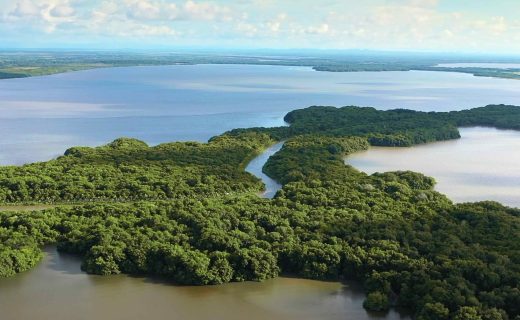

Sustainability
Sighting of 10 spectacled bear return the hope of conservation of the species
4 February 202004th Febrary de 2020
10 spectacled bear individuals identified in the Tatamá National Park return the hope of conservation of the species
- The spectacled bear ( Tremarctos ornatus), also called an Andean bear, is an umbrella species for Andean forests, its protection contributes to the conservation of other wild species and strategic ecosystems.
-
The identification of these 10 individuals was carried out within the framework of the Park Monitoring Program and the activities of the Conservamos la Vida program, led by the Grupo Argos Foundation, Natural National Parks and WCS Colombia.
-
In the more than 11 thousand km2 of area of influence of the program, between the departments of Valle del Cauca, Cauca and Risaralda there is evidence of the occupation of the species in 70% of the area.
One of the trap chambers installed in the Tatamá National Natural Park, the area of influence of the Conservamos la Vida program, recorded the presence of 10 new spectacled bear individuals, a species classified as vulnerable to extinction and the only one that inhabits the Andes Mountains, between Colombia, Venezuela, Peru, Ecuador and Bolivia.
“We are very excited about the new individuals of the species that we found because it shows that, working as a team with the inhabitants of the region and an important group of strategic allies, we are achieving the conservation of the Andean bear. Allied families have become guardians of the bear and thanks to the sustainable production initiatives of the program, we have managed to contribute to the improvement of their quality of life, ”said Ana Mercedes Villegas, Executive Director of the Grupo Argos Foundation.
With an investment of more than COP 3 billion, more than 2,000 hectares of intervened conservation and environmental education strategies for nearly 800 students and teachers, Conservamos la Vida has managed to establish a biological corridor so that the species can move freely Through the territory. This alliance has managed the signing of 52 agreements with farmers and property owners in the area and, in 2020, it is expected that with the signing of new agreements, the recovery of the connectivity of this fundamental corridor for the species, which covers the Tatamá, Farallones and Munchique National Parks.
“The protection of the spectacled bear ensures the conservation of the moors, cloud forests and the species that inhabit these ecosystems. From these spaces comes much of the water that Colombians consume. The presence of the spectacled bear is an indicator of good ecosystem health, so this sighting is a very important signal about the conservation work that we are carrying out, ”said Juan Carlos Troncoso Saavedra, Head of the Tatamá National Natural Park.
The Andean bear is the only one in South America and has a presence in 23 Natural National Parks of our country. Considered the guardian of the moors, their litters can have up to four offspring and, in adulthood, can reach a weight greater than 170 kilos. It is a mostly vegetarian animal, which, by constantly migrating, disperses seeds over large areas, so it plays an important role for the renewal, conservation and future of the Andean forests.
About Conserve Life
We conserve Life promotes the healthy coexistence between the Andean bear and the rural communities that live near the National Natural Parks Tatamá, Farallones de Cali, Munchique and recently, Las Hermosas, in the Western Cordillera of Colombia. It is developed thanks to the alliance between the Grupo Argos Foundation, Natural National Parks and WCS, with the support of Celsia, the Regional Autonomous Corporation of Valle del Cauca, the Mario Santo Domingo Foundation, Smurfit Kappa, among other entities.
In 2019, the program was among the five finalists of the P3 Impact Award, convened by the Concordia organization, the University of Virginia and the United States Office for Global Alliances. This is the most relevant recognition at international level to highlight alliances between governments and companies that are committed to a common purpose.
Get to know the video of the sighting by clicking here.
Mas noticias
-
 News
News -
 News
NewsGrupo Argos and Cementos Argos Once Again Among the World's Most Sustainable Companies According to the Dow Jones Sustainability Index
23 December 2024 Read more -
 News
NewsGrupo Argos and the Autonomous Corporation of Atlántico (CRA) launched the book "The Memories of the Mangrove" as part of the Somos Sostenibilidad event.
12 December 2024Grupo Argos and the Autonomous Corporation of Atlántico (CRA) launched the book "The Memories of the Mangrove" as part of the Somos Sostenibilidad event.
Read more -
 Grupo Argos Foundation
Grupo Argos FoundationGrupo Argos Foundation, Terraformation, the Government of Antioquia, and the Province of Cartama sign an agreement for over COP 5 billion to promote sustainable livestock farming
6 November 2024Grupo Argos Foundation, Terraformation, the Government of Antioquia, and the Province of Cartama sign an agreement for over COP 5 billion to promote sustainable livestock farming
Read more -
 Grupo Argos Foundation
Grupo Argos FoundationGrupo Empresarial Argos will reach the record figure of one million mangrove seedlings planted in the Colombian Caribbean in the first quarter of 2025
30 October 2024Grupo Empresarial Argos will reach the record figure of one million mangrove seedlings planted in the Colombian Caribbean in the first quarter of 2025
Read more
